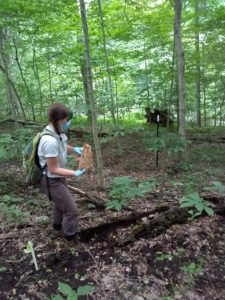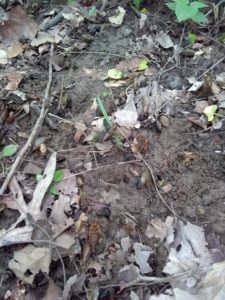The Brood X cicadas have emerged! Their cicada song can be heard all around
Bloomington, Indiana. Their emergence holes surround every tree. The squirrels, birds, and even
my dog Piper are all getting fat from eating way too many of these tasty morsels.
Their dead bodies are beginning to litter the ground–ewwww gross! By “ewwww gross,” we actually mean
super cool because each decaying cicada carcass is actually a little packet of nitrogen. Nitrogen
is the nutrient that most commonly limits plant growth and so all those little cicada bodies are
like plant super foods. As they decompose, the nitrogen is released back to the soil fertilizing any
plants nearby.
CICADAS AS CATALYSTS–STUDYING THE LONG-TERM EFFECTS OF A SHORT-TERM INSECT EMERGENCE
When the cicada carcasses fall to the ground, they are like little packets of nitrogen, the nutrient plants need most. The Lau Lab is studying the effects of this cicada fertilizer on plants and their insect and microbe friends and foes. We’re investigating questions like:
- Will the cicada emergence open opportunities for invasive plants to come in to our native forests?
- How will the cicada emergence affect the billions of microbes living in the soil that usually help plants obtain nitrogen?
- And even will cicadas affect how plants and/or microbes evolve?
To answer these questions we’re setting up a really big experiment involving more than 300,000 cicada carcasses. We’re adding cicada bodies to some areas of the forest, while removing them from others. By measuring plants and the animals and microbes they interact with in this experiment, we can start to understand both the short- and long-term effects of this two month long, loud cicada dance party.
Collect Cicadas – Earn Rewards!
For our experiments, we need more than 300,000 cicada carcasses…that’s a lot of dead cicadas!!! While many cicadas are still flying around B-town, many others are beginning to pass away, and their bodies are falling to the ground. We’d love your help collecting them!
If you’d like to help collect, participate in one of our Cicada Club events. You can earn rewards including ice cream and gift certificates to some Bloomington favorites. Check out the details of our next event!
June 21, 2021
A few friendly cicada collectors have asked when we’ll start finding answers to our questions. Right now, we’re focused on getting our treatments installed (cicadas added to some plots and removed from others). The forest plots where we work are a bit behind much of Bloomington so we’re only beginning to remove cicada plots from the plots in the removal treatment. Then it will take some time for our cicada treatments to affect the amounts of nitrogen available to plants. As a result, most of our measurements won’t take place until July and August.
June 16,2021
We’re scaling up fast! The cicada team added another ~4,000 cicada carcasses to each plot. This is our 3rd addition and we’re approaching the halfway point. Sierra is working in the plots now measuring tree seedlings and reports, “It’s getting smelly.” (We tried to avoid beaning her with cicadas when we were adding them).
June 8, 2021
We started adding cicada carcasses to our plots! Check out these photos from our first cicada addition. Our first addition was relatively small (~1,000 cicadas per 100m2 plot), but even then you can see those little nitrogen-filled cicada bodies littering the forest floor.


Cicadas are amazing insects! Enjoy the activities below and learn a little more about these fascinating creatures.
Cicada Coloring Page – Did you know that, while most of the 17 year cicadas have red eyes, there are a small number that actually have white or even blue eyes? These are natural variations that are presumed to be caused by mutations or rare alleles. What color will your cicada’s eyes be?
Cicada Word Search – Find the words in the word search and learn a little more about these amazing creatures at the same time! Did you know that the tymbal is the body part that male cicadas use to “sing”?
Cicada Mad Libs – Do you have a friend that doesn’t love cicadas? Let’s fix that! Write a letter, Mad Libs style, to explain just how amazing these insects are.